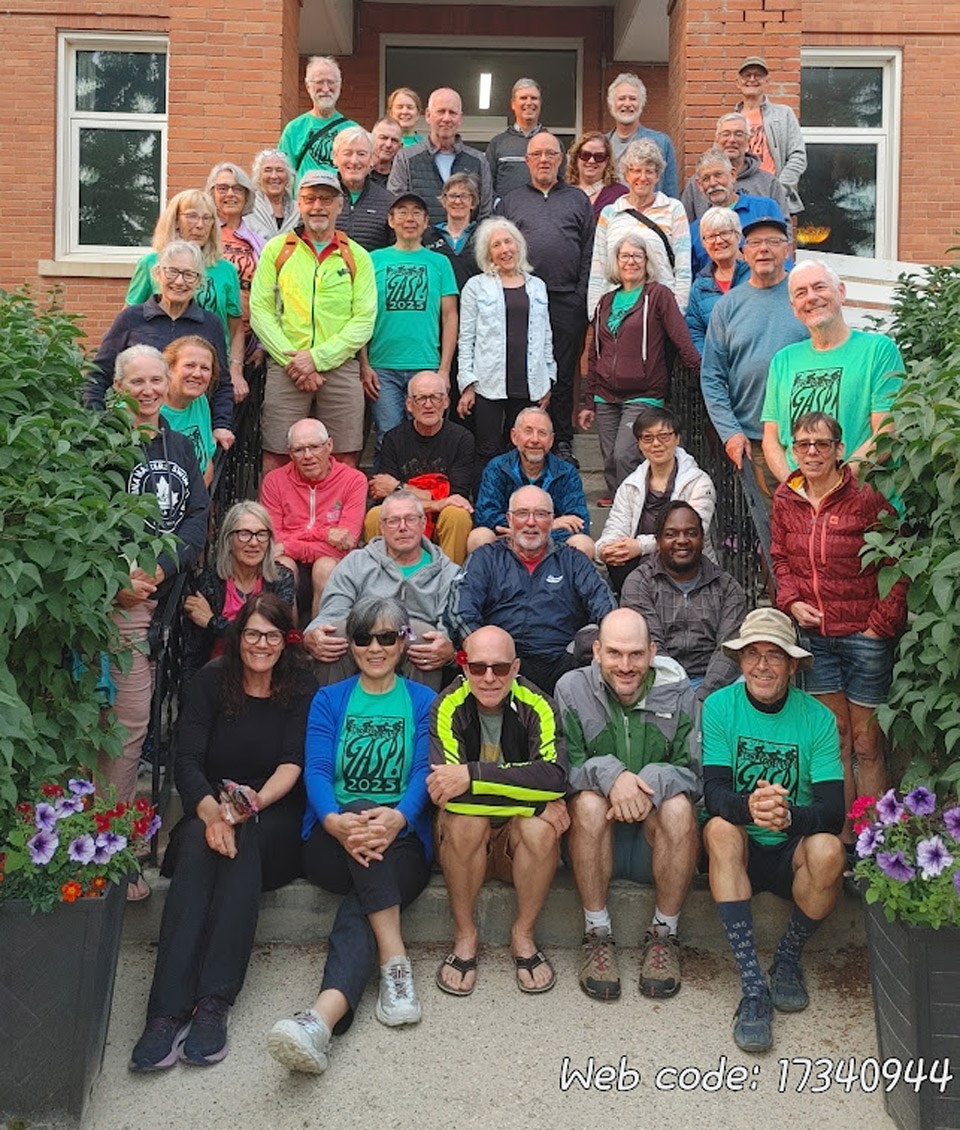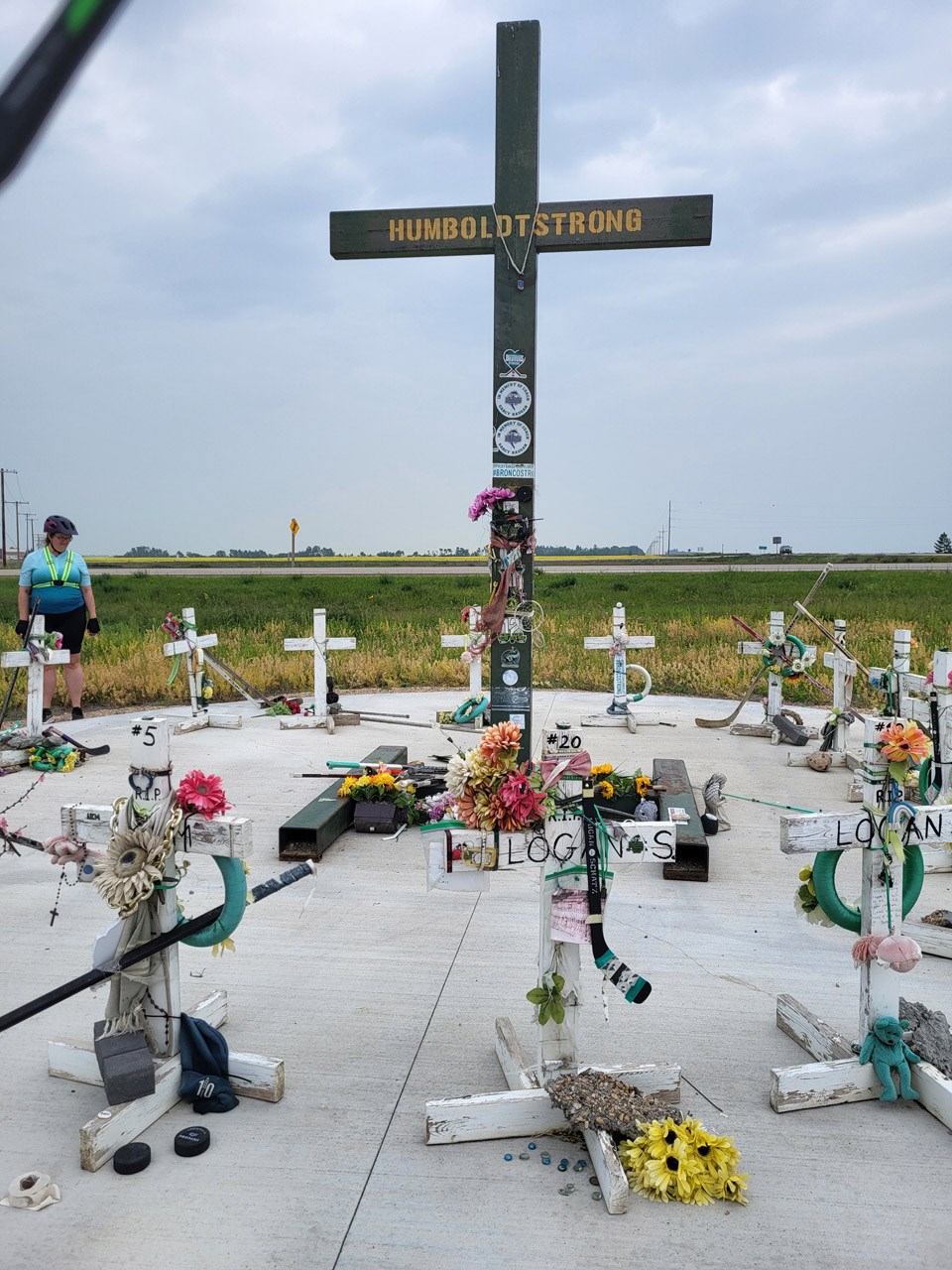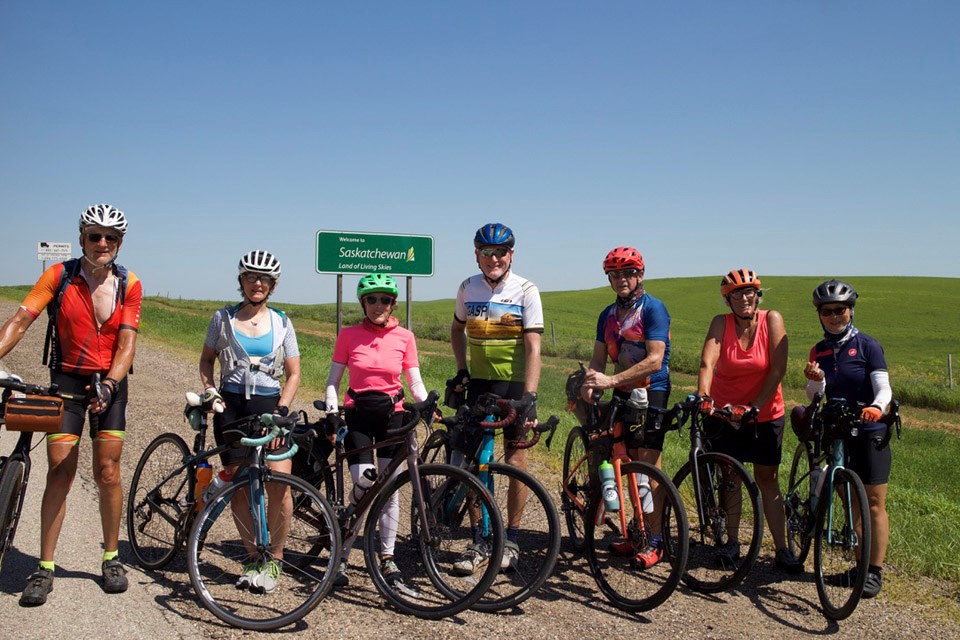OUNGRE, Sask. — The 82 cyclists who pedalled from Tobin Lake to Oungre over seven days in July in the 21st Great Annual Saskatchewan Pedal tour accomplished the feat under the slogan “From Boreal Forest to the Border.”
The first group of 40 cyclists which left Tobin Lake on July 19, included Don Cook of Saskatoon, chair of the organizing committee, who has been participating as a cyclist or administrator since 2009, and former Kamsack resident Ken Achtymichuk of Outlook, who has been involved since the tour began in 2005 as a special event to help celebrate Saskatchewan’s centennial. The group arrived at its destination, Oungre, on the Canada-USA border, on July 25.
The second group of 42 cyclists, which left a day later and completed the trip a day later than the first group, included Brenda and Warren Andrews of Cote Siding.
This year marked the largest group to participate in the tour, Cook said when interviewed by telephone on July 28. The annual event began in 2005 with only 30 to 40 cyclists and each year a different route through the province has been identified and cycled.
Covering a total distance of about 600 kilometres in seven days this year means the cyclists averaged 85 to 90 kilometres a day, Cook said.
The first day, the cyclists rode from Tobin Lake to Tisdale, which is a distance of about 95 kilometres; the second day, Tisdale to Wadena, 115 km; third day, to Kelliher, 85 km; fourth day, to Fort Qu’Appelle, 70 km; fifth day, to Vibank, 75 km; sixth day, to Weyburn, 80 km, and the last day, from Weyburn to Oungre, which is a distance of about 75 km.
The tour is a week-long camping trip, Cook said, explaining that at each stop, participants set up a camp with their luggage and other belongings having been transferred by van that arrived at each stop before the cyclists.
“We do it because we enjoy it,” he said, describing the cyclists as “a moving community of people,” who have ranged in age from a few teenagers to participants in their 80s.
But basically, this is an activity for empty nesters and retirees, who have the time, he said. The average age is about 60 years.
The weather in Saskatchewan in July is sometimes hot, but this year it was surprisingly cool with a bit of rain and a bit of wind, which can be normal for the province in summer, he said..
Regarding the smoke from the wildfires, Cook said there had been a few days with haze, but there were no days with an air quality index that would have prevented the ride.
“The folks who ride are hardy,” he said. “They are physically strong, mentally capable and quite driven.
“Over the years, we’ve covered a lot of the province and a lot of communities,” he said. “It is a joy to visit all the communities we go through and stay in. It is so wonderful to see how vibrant rural communities in Saskatchewan are.
“When you experience them first-hand, it’s awesome. The services are great.
“It’s heartwarming to see how people come together to make camp at pre-arranged locations,” he said, adding that the cyclists have simple needs: a grazing field for tents, a place for toilets and showers and they take advantage of local restaurants.
It is a series of great experiences, he said, explaining that the cyclists are not a parade as they tend to leave camp in small groups of a few at a time, “under their own steam,” while the luggage vans stop en route to offer water and snacks if needed every 30 or 40 kilometres.
“People we meet on the tour are usually curious,” he said, adding that the route selected usually avoids the major highways.
“The motorists are really good, and usually give the cyclists plenty of room on the roads.”
Cook said that an organizing committee meets about once a month, mostly on the Internet on Zoom, and will have identified the next year’s tour before the end of the previous year.
Cook deserves a lot of credit organizing the tours, said Ken Achtymichuk. He’s the one who assures the facilities and food will be available for everyone.
With seven nights, seven stops, someone has to make all the arrangements, including assuring that the highways selected are okay. It involves lots of planning, Achtymichuk said. “Don definitely drove the selected route a couple of times.”

This is a group photo of the 40 participants of Group 1 of this year’s bike tour. Former Kamsack resident Ken Achtymichuk of Outlook is seated at the far right of the bottom row. | Photo by Donald Cook
The son of Kaye Achtymichuk of Kamsack and the late Charlie Achtymichuk, Ken’s participation began as a driver of the support van, and evolved into a participating cyclist. He said he had looked forward to the tours as a camping trip for himself and his daughter. He has shared the support service with others and was often able to alternate driving the van and cycling.
The first tour was across Saskatchewan from Alberta to Manitoba, and several tours were a loop starting and ending at Yorkton, he said. This year was a bit different in that a bus picked up participants in Regina, Saskatoon and Prince Albert to take them to Toban Lake, and then after the ride was completed, the bus took the participants back to their cities.
Achtymichuk said he enjoys the tours and the community of participants.
“I don’t normally see the cyclists other than on the tours and I look forward to seeing them,” he said, explaining that when cycling alongside someone, stopping for a stretch, or for a drink of water or at a restaurant, “you get to know one another.”
“This year's tour was our third consecutive trip,” Brenda Andrews said of the tour taken with her husband, Warren. “We enjoy visits with the other participants, many of whom have had interesting travels. Inevitably, we make new friends.
“The small towns have some of the best homemade food anywhere,” she said. “We travel along the highways seeing various artworks, people on farms and acreages have made.
“Our sag wagon drivers are lots of fun and give us good support, allowing us a ride whenever we need it,” she said.
In cycling, a "sag wagon," also known as a broom wagon or follow vehicle, is a support vehicle that follows a group of cyclists, usually during long rides or races, according to an Internet query. It's primarily used to assist riders who are unable to continue due to mechanical issues, fatigue, or other problems. The sag wagon typically carries spare parts, tools, food, water, and sometimes even extra bicycles.
Cook said the Great Annual Saskatchewan Pedal operates under the umbrella of the Saskatchewan Cycling Association and persons wishing additional information, such as who to contact if one is interested in participating in next year’s tour, may contact saskcycling.ca.

The crosses at the Humboldt memorial at the crash site, which the tour passed by this year. | Photo by Brenda Andrews

.png;w=120;h=80;mode=crop)

